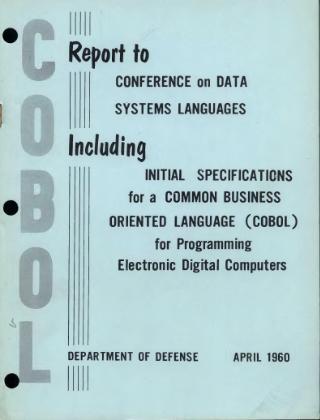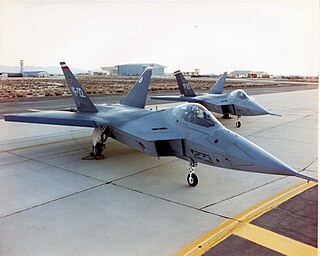In computing, a compiler is a computer program that translates computer code written in one programming language into another language. The name "compiler" is primarily used for programs that translate source code from a high-level programming language to a low-level programming language to create an executable program.

COBOL is a compiled English-like computer programming language designed for business use. It is an imperative, procedural and, since 2002, object-oriented language. COBOL is primarily used in business, finance, and administrative systems for companies and governments. COBOL is still widely used in applications deployed on mainframe computers, such as large-scale batch and transaction processing jobs. Many large financial institutions were developing new systems in the language as late as 2006, but most programming in COBOL today is purely to maintain existing applications. Programs are being moved to new platforms, rewritten in modern languages or replaced with other software.
PL/I is a procedural, imperative computer programming language initially developed by IBM. It is designed for scientific, engineering, business and system programming. It has been in continuous use by academic, commercial and industrial organizations since it was introduced in the 1960s.
MAD is a programming language and compiler for the IBM 704 and later the IBM 709, IBM 7090, IBM 7040, UNIVAC 1107, UNIVAC 1108, Philco 210-211, and eventually IBM System/370 mainframe computers. Developed in 1959 at the University of Michigan by Bernard Galler, Bruce Arden and Robert M. Graham, MAD is a variant of the ALGOL language. It was widely used to teach programming at colleges and universities during the 1960s and played a minor role in the development of Compatible Time-Sharing System (CTSS), Multics, and the Michigan Terminal System computer operating systems. The original version of the chatbot ELIZA was written in MAD-SLIP.
The A-0 system was an early compiler related tool developed for electronic computers, written by Grace Murray Hopper in 1951 and 1952 originally for the UNIVAC I. The A-0 functioned more as a loader or linker than the modern notion of a compiler. A program was specified as a sequence of subroutines and its arguments. The subroutines were identified by a numeric code and the arguments to the subroutines were written directly after each subroutine code. The A-0 system converted the specification into machine code that could be fed into the computer a second time to execute the said program.
FLOW-MATIC, originally known as B-0, was the first English-like data processing language. It was developed for the UNIVAC I at Remington Rand under Grace Hopper from 1955 to 1959, and helped shape the development of COBOL.

UNIVAC was a line of electronic digital stored-program computers starting with the products of the Eckert–Mauchly Computer Corporation. Later the name was applied to a division of the Remington Rand company and successor organizations.
The Syntax/Semantic Language (S/SL) is an executable high level specification language for recursive descent parsers, semantic analyzers and code generators developed by James Cordy, Ric Holt and David Wortman at the University of Toronto in 1980.

Robert William Bemer was a computer scientist best known for his work at IBM during the late 1950s and early 1960s.

The history of programming languages spans from documentation of early mechanical computers to modern tools for software development. Early programming languages were highly specialized, relying on mathematical notation and similarly obscure syntax. Throughout the 20th century, research in compiler theory led to the creation of high-level programming languages, which use a more accessible syntax to communicate instructions.
XPL, for expert's programming language is a programming language based on PL/I, a portable one-pass compiler written in its own language, and a parser generator tool for easily implementing similar compilers for other languages. XPL was designed in 1967 as a way to teach compiler design principles and as starting point for students to build compilers for their own languages.
WATFIV, or WATerloo FORTRAN IV, developed at the University of Waterloo, Canada is an implementation of the Fortran computer programming language. It is the successor of WATFOR.

IBSYS is the name of a discontinued tape-based operating system that IBM supplied with its IBM 709, IBM 7090 and IBM 7094 computers, and of a significantly different, though similar operating system provided with IBM 7040 and IBM 7044 computers. IBSYS was based on FORTRAN Monitor System (FMS) and Bell Labs' "BESYS" rather than the SHARE Operating System. IBSYS directly supported several older computer language compilers and assemblers on the $EXECUTE card: 9PAC, FORTRAN and IBSFAP. Newer language processors ran under IBJOB.

The Air Force Systems Command (AFSC) is an inactive United States Air Force Major Command. It was established in April 1951, being split off from Air Materiel Command. The mission of AFSC was Research and Development for new weapons systems.
Jean E. Sammet was an American computer scientist who developed the FORMAC programming language in 1962. She was also one of the developers of the influential COBOL programming language.
LINC is a fourth-generation programming language, used mostly on Unisys computer systems.
Douglas Taylor "Doug" Ross was an American computer scientist pioneer, and chairman of SofTech, Inc. He is most famous for originating the term CAD for computer-aided design, and is considered to be the father of Automatically Programmed Tools (APT), a programming language to drive numerical control in manufacturing. His later work focused on a pseudophilosophy he developed and named Plex.

In computing, a compiler is a computer program that transforms source code written in a programming language or computer language, into another computer language. The most common reason for transforming source code is to create an executable program.
Plus is a "Pascal-like" system implementation language from the University of British Columbia (UBC), Canada, based on the SUE system language developed at the University of Toronto, c. 1971.

Programming Languages: History and Fundamentals is a book about programming languages written by Jean E. Sammet. Published in 1969, the book gives an overview of the state of the art of programming in the late 1960s, and records the history of programming languages up to that time.






